One of the last Australian pre-decimal coins kept as a souvenir
Obverse
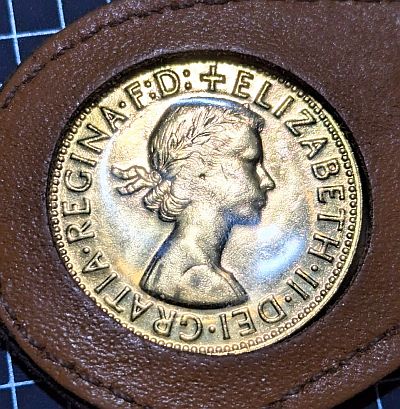
The obverse of the coin features the Mary Gillick portrait of Queen Elizabeth II. Lettering around the edge reads “ELIZABETH·II·DEI·GRATIA·REGINA·F:D:”, which translates to “Elizabeth II by the Grace of God, Queen, Defender of the Faith”. The 1953 Penny, and 1953-4 Half Penny of the same design did not include “F:D”. I can’t find a specific reference for why that is, as the George VI Penny up to 1952 DID include either “F:D:” or the expanded “FIDEI DEF”. If anyone knows, please do let me know! The penny is made from bronze; however, this one has been gilded when it was placed in the keyring.
The Mary Gillick portrait was the first portrait of Queen Elizabeth II used on Australian coins from 1953 through to the last pre-decimal coins issued in 1964. This portrait was also used on coins from:
- Canada
- New Zealand
- Rhodesia and Nyasaland
- South Africa
- Sri Lanka
- the United Kingdom
- and Zimbabwe
The portrait shows the young Queen wearing a laurel wreath in her hair. This hair accessory goes back to the ancient Greek God Olympus, and from him, to winning athletes in the Ancient Games. I can find plenty of coins featuring laurel branches, but I can’t find any circulating coins with a ruler wearing a laurel wreath newer than this portrait of Elizabeth II (The last circulating coins to use these portraits were the final pre-decimal coins from the UK, which were minted up until 1970. There are numerous non-circulating commemoratives, particularly those honouring the Queen after her passing, which have been issued featuring the portrait.
Reverse
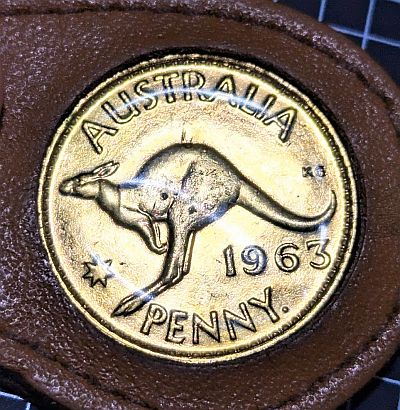
The reverse features a Kangaroo, bounding left, above the date and the value. The dot after the word “Penny” denotes this as being minted at the Perth Mint. Coins without that extra dot were minted in Melbourne, however for this series (minted 1955-1964), Melbourne was only used for 1955, 1956, 1958, 1959 and 1964. In those years, Perth also produced coins.
The penny and half penny were always issued in Bronze and were the only pre-decimal Commonwealth bronze coins. Australia never had a farthing – a fact argued in court about the price of milk in 1943. Earlier pennies and half pennies (1911 – 1939) had the denomination written in the centre of the coin. One thing I like about the later penny and half penny (1938 – 1964) is the way the Kangaroo faces right on the half penny and left on the penny:
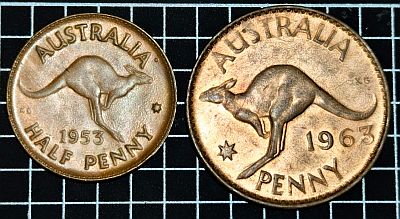
Of this final 1955 – 1964 version of the penny featuring Elizabeth II, most are fairly common, with only the 1955 and 1959 coins issued in Melbourne having mintages under 10 million (the 1959 is the key date with a mintage of only 1.6 million). No coins were issued in 1965 in preparation for decimalisation which happened in February 1966. As such, mintages for all 1960s issues were over 20 million. The 1963 is actually the lowest of those, at only 10 million. So, it’s not surprising some of the later year’s coins were saved aside to be made into souvenirs such as my keyring.
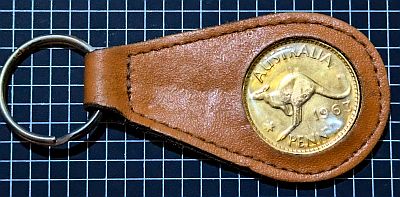
The Kangaroo
The word kangaroo derives from ‘Gangurru’, the name given to Eastern Grey Kangaroos by the Guuga Yimithirr people of Far North Queensland. Kangaroos are of cultural and spiritual significance to Aboriginal people across Australia.
Here is Little Miss Coin feeding a Kangaroo at a wildlife park:
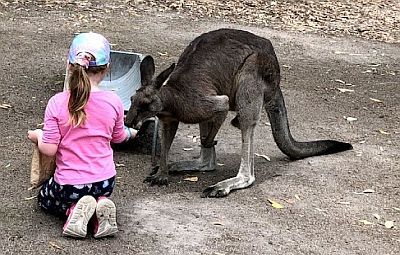
Kangaroos can be aggressive, so it is important to be careful around them.
Kangaroos are the world’s largest marsupials. A Red Kangaroo can weigh 90kg and can grow two metres tall. Wallabies are smaller than Kangaroos. Wallabies are lucky to weigh more than 20kg and rarely reach heights of 1m.
Kangaroos are famous for hopping and can reach speeds of 60kph, clearing more than 8m in a single bound!
Kangaroos on coins
The Kangaroo is arguably the most widely recognised Australian animal. So, it’s not surprising to see it represented on one of the most commonly used pre-decimal coins. The first time it appeared on an official coin was in 1910, on the 3-pence, 6-pence, shilling and florin of Edward VII. These were the first Commonwealth coins issued in Australia after federation in 1901. These were also the last coins to feature Edward VII, who passed away in May 1910. There had been earlier tokens featuring the Kangaroo, and there are later ones as well. You can still purchase Penny Tokens from the Royal Australian Mint.

Here is a souvenir token issued by an Australian newspaper to commemorate the 1992 Barcelona Olympics. The Kangaroo is in the same pose as on the Penny:
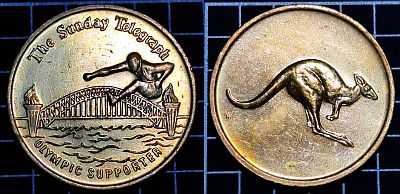
Currently, the kangaroo features on the standard 50-cent coin, as one of the supporters of the Coat-of-Arms, and on the “mob of roos” $1 coin, featuring 5 of the animals. These designs have been unchanged since their introduction in 1966 and 1984 respectively.
Finally, here is another representation of the newer and older Australian Penny and half-penny. I got these 450mm diameter rusted metal signs from Old ‘n’ Dazed, and they look fantastic on the fence:

What do you think of them? Have you got any coin-related art? Do share it with us!


Leave a Reply